
The scarlet gourds are a genus with 25 species. It is distributed in sub-Saharan Africa and with one species, C. grandis also in South Asia and Southeast Asia, and it is also introduced into the New World. Incidentally, C. grandis is also a cultivated crop and it is used for culinary and medical purposes.

Nepenthes neoguineensis is a tropical pitcher plant native to the island of New Guinea, after which it is named.
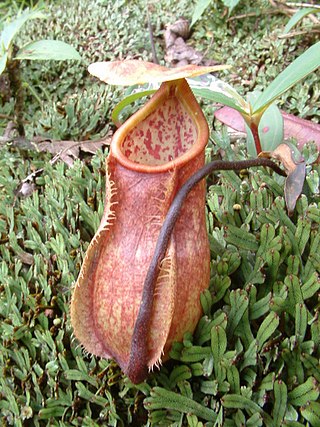
Nepenthes papuana is a tropical pitcher plant endemic to New Guinea. The specific epithet papuana is derived from Papua, an alternative name for the island.
Symplocos nairii is a species of plant in the family Symplocaceae. It is endemic to India. Known to be a shrub or small tree, up to 8 m tall; young branchlets angular, glabrous. Leaves simple, alternate, spiral, 7-10 x 4.5–5 cm, elliptic to obovate, apex obtuse, base subcordate and asymmetric, margin serrate, glabrous; midrib canaliculate above; secondary nerves ca. 8 pairs; tertiary nerves obliquely and distantly percurrent; petiole ca. 0.3 cm long, planoconvex in cross section, glabrous. Flowers axillary, solitary or racemes, 1–2 cm long; flowers sessile. Drupe, cylindrical or ellipsoid, 1.1 cm long.
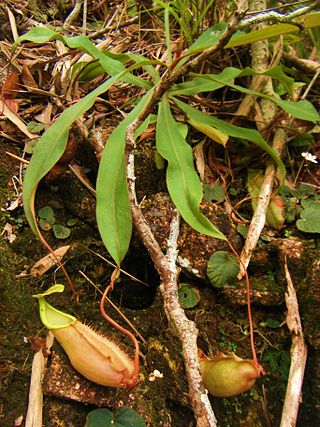
Nepenthes chang is a tropical pitcher plant endemic to the Banthad Mountains of central Thailand, where it grows at elevations of 300–600 m above sea level. It is thought to be most closely related to N. kampotiana.

Coccinia intermedia is a species of Coccinia which was first described in 2011 by Norbert Holstein.

Corydalis micrantha is a species of flowering plant in the poppy family (Papaveraceae), native to the United States. Common names include smallflower fumewort, southern corydalis, and golden corydalis.
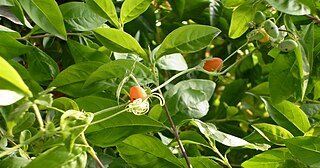
Ctenolepis garcini, also known as Garcin's bur cucumber, is a tender climber of the family Cucurbitaceae. It is one of the three species of the genus Ctenolepis. It is widely distributed in South India and Ceylon. The species was named after French botanist Laurent Garcin, who traveled India in the 18th century.

Cadaba aphylla ("Swartstorm") is one of the many species in the genus Cadaba. It is indigenous to southern Africa.

Coccinia grandiflora is an East African species of Coccinia which was first described in 1895 by Alfred Cogniaux.

Coccinia sessilifolia is a species of Coccinia from southern Africa.
Coccinia pwaniensis is an East African species of Coccinia that was first described in 2010.
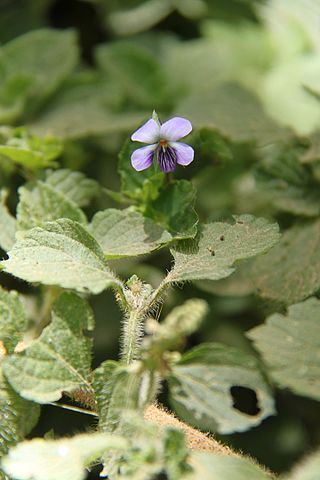
Viola abyssinica is a low perennial plant with long trailing stems and whitish or light purple flowers with purple markings on the lip, that is assigned to the violet family. In the wild it grows in moist grassland, forest glades and margins, at altitudes between 1200 and 3400 m (3900–11.000 ft), in eastern Africa, from South Africa to Ethiopia, in Cameroun and Nigeria, and on Madagascar and Bioko. Vernacular names are bezongozongo in Madagascar, and dukunsha in Ethiopia.

Rosa abyssinica is the only rose native to Africa. Europeans first learned of the rose in the writings of 19th-century Scottish botanist Robert Brown. Rosa abyssinica is included in the genus Rosa, and the family Rosaceae. No subspecies are listed in the Catalogue of Life.
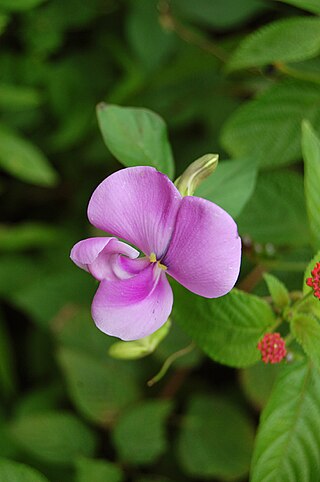
Vigna vexillata, the Zombi pea or wild cowpea, is a variable, perennial climbing plant that is pantropical, found in regions such as Ethiopia, Nigeria, and Venezuela.
Prunus mugus is a species of cherry found in Yunnan province of China and nearby areas of Myanmar and Tibet. A prostrate shrub 1 m tall, it prefers to grow in thickets in the krummholz zone on mountain slopes from 3200 to 3,700 m or even 4,075 m (13,400 ft) above sea level. Heinrich von Handel-Mazzetti, who discovered it, named the species after Pinus mugo, the dwarf mountain pine.

Solena amplexicaulis, commonly known as the creeping cucumber, is a species of plant in the family Cucurbitaceae, native to tropical southern Asia. The fruits, leaves, roots and shoots have use as food and in traditional medicine.

Ibervillea sonorae is a tuberous perennial plant in the Cucurbitaceae family known by the common names wereke, wareque, guarequi, and coyote melon. It is a highly variable species characterized by a large, succulent tuberous root, which in the dry sand of its native habitat resembles a gray, dust-covered boulder. Emerging from the root yearly are long, flexible liana-like shoots, which reach a length of three or more meters. This species is native to northwestern Mexico, being found in the states of Baja California, Baja California Sur, Sonora and Sinaloa.

Diospyros paniculata, or the panicle-flowered ebony, is a species of tree in the ebony family. Endemic to the Western Ghats area of India and parts of Bangladesh, the species is currently listed as Vulnerable in the IUCN Red List.
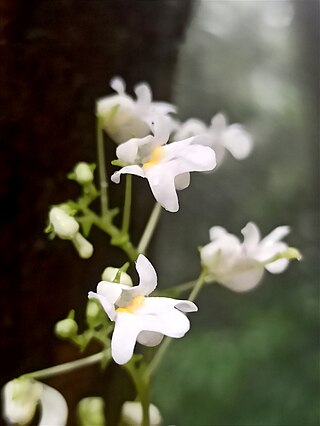
Impatiens dendricola is a herbaceous flowering plant in the family Balsaminaceae endemic to Western Ghats.

















